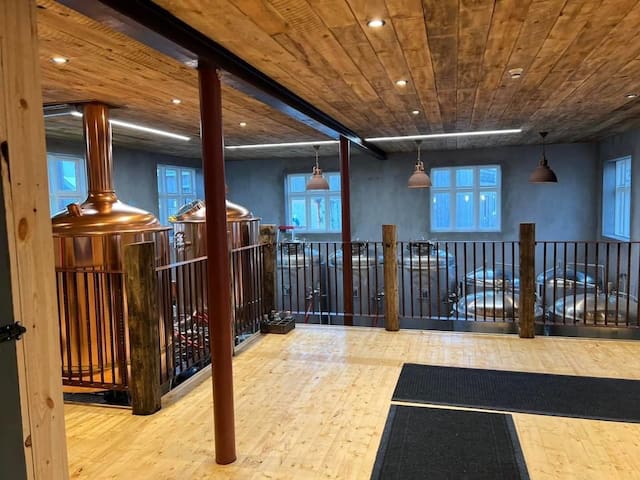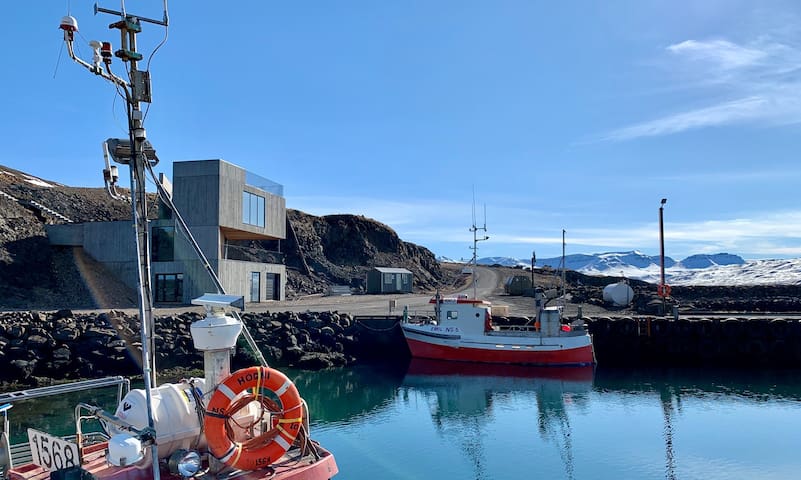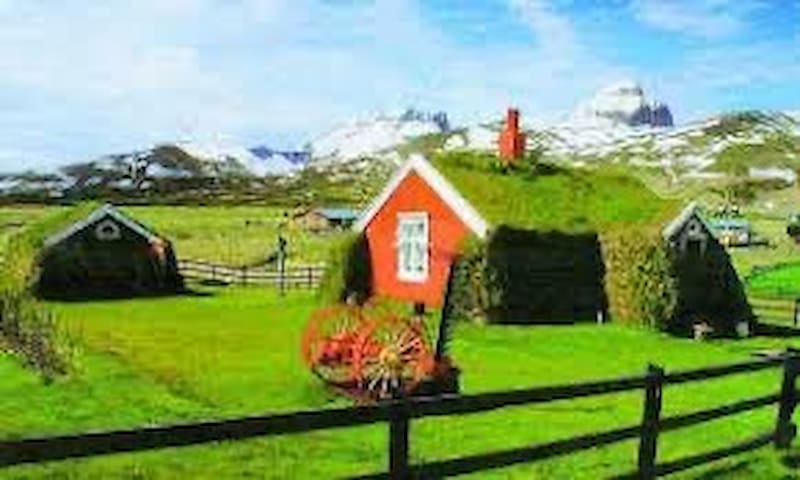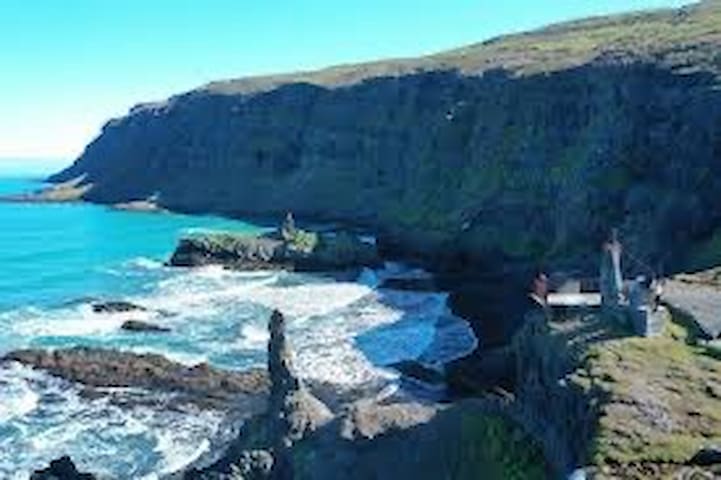Food Scene
General Info:
Frystiklefinn, which translates to “The Freezer” is the name of our restaurant at Blábjörg Resort. From 1949-1991 this building served as a fish factory, the part of the building that is now the restaurant, was once the freezer of the fish factory.
We are very proud to be able to focus on local and fresh ingredients from our area. All of our fish comes from the local fish factory and all of the meat comes from our friends in Hlíðartún, in Njarðvík. We are in close contact with food producers in our area of east Iceland and we try to highlight the ingredients this beautiful area has to offer. Our chef puts a lot of ambition and pride into making as much as we can from scratch.
Local food guarantee:
On our menu, next to most dishes, you will see a small yellow star. That star is called the “East Iceland star” and means this dish contains local ingredients.
East Iceland offers a great variety of amazing ingredients like; meat, fish, dairy products, vegetables, and much more. Our kitchen is proud and honored to work with these fantastic products. If you order food from our menu that has the little star on the side, and you plan on sharing it on social media, please use the hashtag #austurland
We also have our own craft beers on draft and cans from our very own craft brewery, KHB brewery&distillery. You can also try out our lovely coctails made from our Gin and the local moonshine, called Landi. The Gin has received silver medal in London Spirits Competition 2 years in a row.
Frystiklefinn restaurant
General Info:
Frystiklefinn, which translates to “The Freezer” is the name of our restaurant at Blábjörg Resort. From 1949-1991 this building served as a fish factory, the part of the building that is now the restaurant, was once the freezer of the fish factory.
We are very proud to be able to focus on local and fresh ingredients from our area. All of our fish comes from the local fish factory and all of the meat comes from our friends in Hlíðartún, in Njarðvík. We are in close contact with food producers in our area of east Iceland and we try to highlight the ingredients this beautiful area has to offer. Our chef puts a lot of ambition and pride into making as much as we can from scratch.
Local food guarantee:
On our menu, next to most dishes, you will see a small yellow star. That star is called the “East Iceland star” and means this dish contains local ingredients.
East Iceland offers a great variety of amazing ingredients like; meat, fish, dairy products, vegetables, and much more. Our kitchen is proud and honored to work with these fantastic products. If you order food from our menu that has the little star on the side, and you plan on sharing it on social media, please use the hashtag #austurland
We also have our own craft beers on draft and cans from our very own craft brewery, KHB brewery&distillery. You can also try out our lovely coctails made from our Gin and the local moonshine, called Landi. The Gin has received silver medal in London Spirits Competition 2 years in a row.
Sightseeing
General Info:
KHB Brewery is located in one of the oldest houses in Borgarfjörður eystri, formally known as “Gamla Kaupfélag” or Old Town Store. Built in 1897, the house has a long and remarkable commerce history. KHB Brewery has been restored to reflect the building's past and honor the great entrepreneurs who have operated there. Their diligence, bravery, and respect for Borgarfjörður eystri are illustrated throughout the story and shines through our production of gin and landi (the Icelandic version of "moonshine").
The restoration of the building, Gamla Kaupfélag, is carried out in collaboration with The Cultural Heritage Agency of Iceland.
Guests can book a tour of KHB where they will learn about the history of the building and businesses that once took place there, as well as the story of bootlegging and moonshine making here in Borgarfjörður. You can hear about the more modern distilling and microbrewing processes used today and end the tour in our taproom with a taste of the stories that made these drinks, as well as the drinks themselves.
The Bar:
In our KHB taproom in the “Gamla Kaupfelagið”, the Old Town Store, we have six beers on tap, from our own brewery and a selection of rotating seasonal beers and guest beers from other up-and-coming microbreweries in Iceland. We offer beer tastings as well as excellent cocktails using our home-brewed Landi (Icelandic moonshine) and Gin. We have a great selection of other spirits and a selection of snacks that complement our beers.
KHB Brugghús Brewery&Distillery
720General Info:
KHB Brewery is located in one of the oldest houses in Borgarfjörður eystri, formally known as “Gamla Kaupfélag” or Old Town Store. Built in 1897, the house has a long and remarkable commerce history. KHB Brewery has been restored to reflect the building's past and honor the great entrepreneurs who have operated there. Their diligence, bravery, and respect for Borgarfjörður eystri are illustrated throughout the story and shines through our production of gin and landi (the Icelandic version of "moonshine").
The restoration of the building, Gamla Kaupfélag, is carried out in collaboration with The Cultural Heritage Agency of Iceland.
Guests can book a tour of KHB where they will learn about the history of the building and businesses that once took place there, as well as the story of bootlegging and moonshine making here in Borgarfjörður. You can hear about the more modern distilling and microbrewing processes used today and end the tour in our taproom with a taste of the stories that made these drinks, as well as the drinks themselves.
The Bar:
In our KHB taproom in the “Gamla Kaupfelagið”, the Old Town Store, we have six beers on tap, from our own brewery and a selection of rotating seasonal beers and guest beers from other up-and-coming microbreweries in Iceland. We offer beer tastings as well as excellent cocktails using our home-brewed Landi (Icelandic moonshine) and Gin. We have a great selection of other spirits and a selection of snacks that complement our beers.
General info:
Hafnarhús Café opened in the spring of 2020 in the Hafnarhólmi marina by the puffin colony. The café is open from early April until the beginning of September and is located on the middle floor of the Hafnarhús building. The building in which Hafnarhús Café is located serves not only guests visiting Hafnarhólmi, but also for use by local fishermen.
What we offer:
In Hafnarhús Café we offer high-quality coffee, homemade cakes, cookies, soup, and sandwiches.
Puffin colony in Hafnarhólmi:
In Hafnarhólmi, the design is optimal for birdwatching. Guests can get very close to the puffins without disturbing them by using boardwalks, platforms, and a birdwatching house that allows guests to admire the puffin in their natural habitat.
Art Exhibitions:
On the top floor of Hafnarhús Café you will find art exhibits during the opening hours of the café, for guests to enjoy while visiting the marina.
Architectural Awards:
The Hafnarhús building was nominated for the European Mies van der Rohe awards. The architect behind the building is Andersen & Sigurdsson, located in Denmark. The construction took 3 years to be built and cost around 200 million Icelandic krona. In 2015 the municipality of Borgarfjörður held a design competition for the architectural work of the design for the building.
Hafnarhus Café
BorgarfjarðurhofnvegurGeneral info:
Hafnarhús Café opened in the spring of 2020 in the Hafnarhólmi marina by the puffin colony. The café is open from early April until the beginning of September and is located on the middle floor of the Hafnarhús building. The building in which Hafnarhús Café is located serves not only guests visiting Hafnarhólmi, but also for use by local fishermen.
What we offer:
In Hafnarhús Café we offer high-quality coffee, homemade cakes, cookies, soup, and sandwiches.
Puffin colony in Hafnarhólmi:
In Hafnarhólmi, the design is optimal for birdwatching. Guests can get very close to the puffins without disturbing them by using boardwalks, platforms, and a birdwatching house that allows guests to admire the puffin in their natural habitat.
Art Exhibitions:
On the top floor of Hafnarhús Café you will find art exhibits during the opening hours of the café, for guests to enjoy while visiting the marina.
Architectural Awards:
The Hafnarhús building was nominated for the European Mies van der Rohe awards. The architect behind the building is Andersen & Sigurdsson, located in Denmark. The construction took 3 years to be built and cost around 200 million Icelandic krona. In 2015 the municipality of Borgarfjörður held a design competition for the architectural work of the design for the building.
Lindarbakki turf house in Borgarfjörður is one of our favorite gems. The turf house is a popular stop for travelers. The house was built right around 1900 and was not considered a special house at the time, but rather one of the last of its kind. Turf houses just like Lindarbakki were all dismantled when more modern building styles were introduced. Thankfully Lindarbakki was left standing and is today one of our most priceless buildings and an important source in Icelandic building history as it shows the architectural style that was used at the time.
The last people to live in Lindarbakki lived there from 1967-1973, but since then Lindarbakki has been owned by Elísabet Sveinsdóttir and her husband Skúli Ingvarsson. Elísabet, or Stella as we call her here in Borgarfjörður, took care of the house alone with help from friends and family after her husband Skúli passed away in 1987. From 1973-2019 Stella came every summer and stayed in Lindarbakki, welcoming guests with stories, and having them sign her guest book. In 2019, Stella handed Lindarbakki over to the municipality of Borgarfjörður and today the house remains exactly as Stella left it.
Lindarbakki
720Lindarbakki turf house in Borgarfjörður is one of our favorite gems. The turf house is a popular stop for travelers. The house was built right around 1900 and was not considered a special house at the time, but rather one of the last of its kind. Turf houses just like Lindarbakki were all dismantled when more modern building styles were introduced. Thankfully Lindarbakki was left standing and is today one of our most priceless buildings and an important source in Icelandic building history as it shows the architectural style that was used at the time.
The last people to live in Lindarbakki lived there from 1967-1973, but since then Lindarbakki has been owned by Elísabet Sveinsdóttir and her husband Skúli Ingvarsson. Elísabet, or Stella as we call her here in Borgarfjörður, took care of the house alone with help from friends and family after her husband Skúli passed away in 1987. From 1973-2019 Stella came every summer and stayed in Lindarbakki, welcoming guests with stories, and having them sign her guest book. In 2019, Stella handed Lindarbakki over to the municipality of Borgarfjörður and today the house remains exactly as Stella left it.
East Iceland’s best-kept secret... Stórurð (Boulder Hollow)
Info: A somewhat difficult hike because of gravelly areas and screes on about 15% of the way. Around 16 km. Traverses 500 m of elevation.
From Vatnskarð pass (431 m), this day's hike starts by going up and crossing the mountain Geldingafjall (640 m), then continuing inland west of Súlur peaks. There are excellent views over Njarðvík, Fljótsdalshérað valley, the black sandy beach of Héraðsflói bay, and perhaps even to Vatnajökull glacier and Mt. Snæfell in the eastern part of the central highlands. We then go down into Stórurð, an expanse of enormous rocks intersected by a small river. Calm turquoise-colored basins of icy water lie hidden among the huge boulders, often with flat banks of short, tender, green grass. Returning from this mysterious place, we can opt either for the hike along the Dyrfjöll (Door Mountains) or the easy way down the valley below Rjúpnafell peak.
ATT: Text is from Borgarfjörður eystri's homepage.
Stórurð
East Iceland’s best-kept secret... Stórurð (Boulder Hollow)
Info: A somewhat difficult hike because of gravelly areas and screes on about 15% of the way. Around 16 km. Traverses 500 m of elevation.
From Vatnskarð pass (431 m), this day's hike starts by going up and crossing the mountain Geldingafjall (640 m), then continuing inland west of Súlur peaks. There are excellent views over Njarðvík, Fljótsdalshérað valley, the black sandy beach of Héraðsflói bay, and perhaps even to Vatnajökull glacier and Mt. Snæfell in the eastern part of the central highlands. We then go down into Stórurð, an expanse of enormous rocks intersected by a small river. Calm turquoise-colored basins of icy water lie hidden among the huge boulders, often with flat banks of short, tender, green grass. Returning from this mysterious place, we can opt either for the hike along the Dyrfjöll (Door Mountains) or the easy way down the valley below Rjúpnafell peak.
ATT: Text is from Borgarfjörður eystri's homepage.
Driving 15 minutes from Borgarfjörður and stopping near to Unaós farm, the hike along Selfljót river to the seashore and to the Stapavík cove starts. Stapavík was a former unloading place for ships. From Stapavík you can hike a rather easy hike along Gönguskarð pass largely along an old riding trail. This was the main route between Borgarfjörður and Fljótsdalshérað valley for 1000 years until the road over Vatnskarð mountain pass was finished in 1955.
The hike over Gönguskarð pass leads to Njarðavík farm and from there you can drive back to Borgarfjörður.
Stapavík
Driving 15 minutes from Borgarfjörður and stopping near to Unaós farm, the hike along Selfljót river to the seashore and to the Stapavík cove starts. Stapavík was a former unloading place for ships. From Stapavík you can hike a rather easy hike along Gönguskarð pass largely along an old riding trail. This was the main route between Borgarfjörður and Fljótsdalshérað valley for 1000 years until the road over Vatnskarð mountain pass was finished in 1955.
The hike over Gönguskarð pass leads to Njarðavík farm and from there you can drive back to Borgarfjörður.
Álfaborgin, also known as, Elf City, sits in the middle of the fjord, rising above the village of Bakkagerði. This is the home of the elves and stories say that the elf queen of Iceland, Borghildur, lives there with her court.
In Borgarfjörður there is a strong belief in elves and residents are happy to live in harmony with elves and will do nothing to jeopardize this arrangement. One of the more famous stories surrounds the church. The story starts with a discussion around a new location for the church in Bakkagerði, the original plan was to build the church on top of Álfaborg, but the elves appeared in a dream and had a different plan.
Álfaborg
Álfaborgin, also known as, Elf City, sits in the middle of the fjord, rising above the village of Bakkagerði. This is the home of the elves and stories say that the elf queen of Iceland, Borghildur, lives there with her court.
In Borgarfjörður there is a strong belief in elves and residents are happy to live in harmony with elves and will do nothing to jeopardize this arrangement. One of the more famous stories surrounds the church. The story starts with a discussion around a new location for the church in Bakkagerði, the original plan was to build the church on top of Álfaborg, but the elves appeared in a dream and had a different plan.






